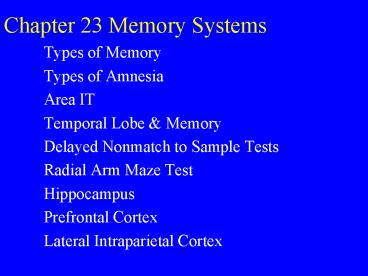Chapter 23 Memory Systems - PowerPoint PPT Presentation
1 / 22
Title:
Chapter 23 Memory Systems
Description:
C. Declarative memory = retention of facts and events. 1. generally accessible for conscious remembering. 2. ... A. Lashley's search for the engram. ( 23.4) ... – PowerPoint PPT presentation
Number of Views:54
Avg rating:3.0/5.0
Title: Chapter 23 Memory Systems
1
Chapter 23 Memory Systems
- Types of Memory
- Types of Amnesia
- Area IT
- Temporal Lobe Memory
- Delayed Nonmatch to Sample Tests
- Radial Arm Maze Test
- Hippocampus
- Prefrontal Cortex
- Lateral Intraparietal Cortex
2
I. Definitions
- A. Learning the acquisition of new information
- B. Memory the retention of learned information
- C. Declarative memory retention of facts and
events - 1. generally accessible for conscious
remembering - 2. usually easy to store and easy to forget
- D. Procedural memory retention of skills or
behavior - 1. generally not accessible for conscious
remembering - 2. generally require much repetition to
retain, but not so easy to forget
3
I. Definitions
- (23.1)
4
I. Definitions
- E. Short-term declarative memory
- 1. temporary, limited in capacity, requires
repetition - F. Long-term declarative memory
- 1. more permanent, large capacity, does not
require repetition - 2. consolidation process of retention in
long-term memory
5
I. Definitions
- (23.2)
6
I. Definitions
- G. Amnesia loss of memory and/or the ability to
learn - H. Retrograde amnesia (23.3)
- 1. loss of memory prior to trauma
- I. Anterograde amnesia
- 1. loss of ability to form new memories after
trauma
7
II. History - videos
- A. Lashleys search for the engram. (23.4)
- B. Wilder Penfields cortical recordings and
evoked responses. - Video Interview with Donald Hebb
8
II. History
- C. Hebbs cell assembly model. (23.5)
9
III. Inferotemporal Cortex (area IT)
- A. Visual association area (23.6a)
- B. Experimental lesion studies
- 1. loss of visual discrimination task
- 2. basic vision normal
- 3. loss of memory (?)
10
III. Inferotemporal Cortex (area IT)
- C. Face recognition neurons (23.6b)
- 1. face selectivity
- 2. facial memory (?)
- 3. Prosopagnosia
- recall video
11
IV. Temporal Lobe Memory
- A. Temporal lobectomy
- 1. Kluver-Bucy syndrome
- a. visual agnosia / psychic blindness
- B. Hippocampal Transplants (Video)
- 1. Anders Bjorklund - Morris Water Maze (24.25)
12
IV. Temporal Lobe Memory
- B. H.M. (case study)
- 1. epilepsy surgery in 1953
- 2. bilateral medial temporal lobe removed
(23.8) - a. cortex
- b. amygdala
- c. hippocampus
- 3. partial retrograde amnesia
- 4. profound anterograde amnesia
- 5. long-term memories intact
- 6. short-term memory normal
- 7. procedural memory intact
13
IV. Temporal Lobe Memory
- Videos 2 case studies of amnesia
- Peter and Ken
14
IV. Temporal Lobe Memory
- C. Medial temporal lobe structures (23.9)
- 1. hippocampus
- 2. entorhinal
- cortex
- 3. perirhinal
- cortex
- 4. parahippocampal cortex
15
IV. Temporal Lobe Memory
- 5. connections (23.10)
- a. iputs all sensory association areas
- b. outputs hypothalamus via fornix
16
V. Delayed nonmatch to sample tests
- A. Procedure (23.11)
- B. Test of recognition memory
- C. Video - effect of age on memory
17
V. Delayed nonmatch to sample tests (DNMS)
- C. Effects of lesions
- 1. bilateral medial temporal lobe lesion
(23.12) - a. normal test with short delay
- b. increasing errors with increasing delay
(19.10)
18
V. Delayed nonmatch to sample tests (DNMS)
- C. Effects of lesions
- 2. amygdala lesion
- a. no effect other functions of
amygdala? - 3. hippocampal lesion
- a. mild amnesia
- 4. perirhinal cortex lesion
- a. severe memory deficit
19
V. DNMS test
- 5. anterior and dorsomedial thalamic nuclei
(23.13) - a. lesions affect DNMS tests
- b. connections part of Papez circuit
(18.4)
20
VI. Radial Arm Maze Test
- A. Procedure (23.14)
- B. Effect of hippocampal lesion
- 1. repeat errors
- C. Hippocampal place cells (23.15)
21
VIII. Prefrontal Cortex
- A. Location (23.21)
- B. Connections (23.22)
22
VIII. Prefrontal Cortex
- A. Hypothesized functions (19.15)
- 1. complex planning
- 2. problem solving
- 3. memory
- 4. personality / emotion
- B. Videos - effects of frontal lobe stroke on
memory and prefrontal lobotomy, recall Phineas
Gage

